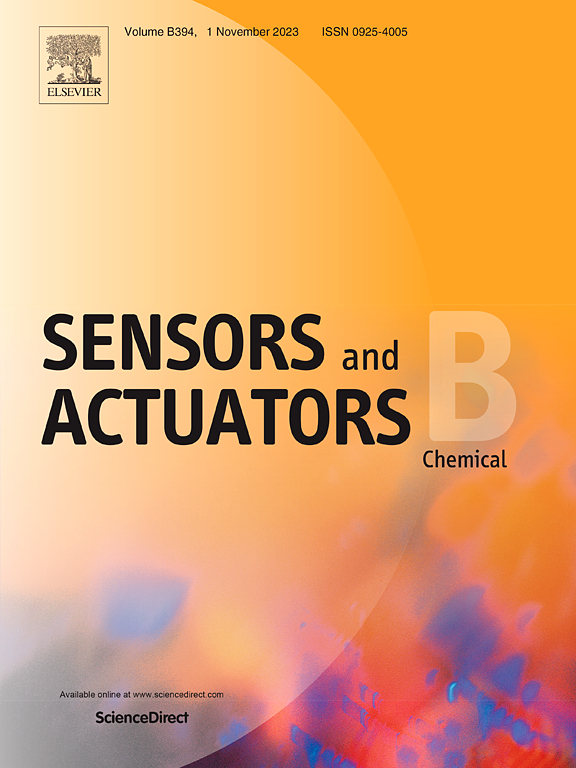自组装纳米球协同mRNA鉴别器用于乳腺癌转移的电化学分析
IF 8
1区 化学
Q1 CHEMISTRY, ANALYTICAL
引用次数: 0
摘要
转移性乳腺癌表现出与mRNA表达谱密切相关的特定特征。因此,特异性mrna的灵敏检测可能有助于在分子水平上早期预警和识别乳腺癌转移,显著改善患者预后。在此,我们提出了一种新的电化学mRNA鉴别器作为分析乳腺癌转移的工具。具体来说,我们制备了自组装的纳米球,它被透明质酸包裹,并装载双特异性核酸酶(DSNs)和针对两种乳腺癌转移相关mrna的电化学标记DNA探针。通过识别cd44(一种在乳腺癌细胞表面高度表达的抗原),纳米球有效地将DNA探针和dsn传递到靶细胞中。随后,细胞内靶mrna与其对应的DNA探针杂交,启动dsn驱动的靶循环,释放出大量相关的电化学分子。最后,通过基于主-客相互作用的富集,该鉴别器允许检测两个目标mrna,分别低至0.170 pM和0.127 pM。同时,这种自组装纳米球协同鉴别器能够有效区分高转移性和低转移性乳腺癌细胞,并在小鼠肿瘤组织样本中表现出良好的实用性。因此,这项工作可能为检测乳腺癌转移相关mrna提供一个有效的工具,有望为分析乳腺癌转移提供见解。本文章由计算机程序翻译,如有差异,请以英文原文为准。
Self-assembled nanosphere-cooperated mRNA discriminator for electrochemical analysis of breast cancer metastasis
Metastatic breast cancer exhibits specific characteristics closely associated with mRNA expression profiles. Consequently, sensitive detection of specific mRNAs may facilitate the early warning and identification of breast cancer metastasis at the molecular level, significantly improving patient prognosis. Herein, we present a new electrochemical mRNA discriminator as a tool for analyzing breast cancer metastasis. Specifically, we prepare self-assembled nanospheres that are coated with hyaluronic acid and loaded with duplex-specific nucleases (DSNs) and electrochemically tagged DNA probes targeting two breast cancer metastasis-related mRNAs. By recognizing CD44—an antigen highly expressed on the surface of breast cancer cells—the nanospheres effectively deliver the DNA probes and DSNs into target cells. Thereafter, intracellular target mRNAs hybridize with their corresponding DNA probes, initiating DSN-driven target recycling and releasing a large number of relevant electrochemical molecules. Finally, through host-guest interaction-based enrichment, this discriminator allows for detecting two target mRNAs down to 0.170 pM and 0.127 pM, respectively. Meanwhile, this self-assembled nanosphere-cooperated discriminator enables effective discrimination between highly metastatic and low-metastatic breast cancer cells and exhibits good utility in mouse tumor tissue samples. Therefore, this work may offer an effective tool for detecting breast cancer metastasis-related mRNAs, which is expected to provide insights into analyzing breast cancer metastasis.
求助全文
通过发布文献求助,成功后即可免费获取论文全文。
去求助
来源期刊

Sensors and Actuators B: Chemical
工程技术-电化学
CiteScore
14.60
自引率
11.90%
发文量
1776
审稿时长
3.2 months
期刊介绍:
Sensors & Actuators, B: Chemical is an international journal focused on the research and development of chemical transducers. It covers chemical sensors and biosensors, chemical actuators, and analytical microsystems. The journal is interdisciplinary, aiming to publish original works showcasing substantial advancements beyond the current state of the art in these fields, with practical applicability to solving meaningful analytical problems. Review articles are accepted by invitation from an Editor of the journal.
 求助内容:
求助内容: 应助结果提醒方式:
应助结果提醒方式:


